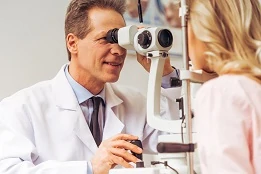Why Don’t Eye Doctors Get LASIK?

The truth is they do! In fact, eye doctors are at least five times more likely to choose vision correction surgery for their own vision needs, according to this study. Further, in the same study, more than 90% of eye surgeons recommend vision correction procedures for candidates in their immediate family.
For someone weighing the risks and benefits of a vision correction procedure like LASIK, SMILE, or ICL, wondering why an eye doctor would choose glasses or contacts for themselves can be confusing. However, as the study shows, most eye surgeons who are candidates for a vision correction procedure report having had a procedure on their own eyes.
Candidacy is the Key
One likely reason you may see an eye doctor wearing glasses is they simply are not a good candidate for a vision correction procedure such as LASIK. Just like any other patient, an eye surgeon’s prescription, health, and eye anatomy all factor into a recommendation for a vision correction procedure. Being a good candidate for a vision correction procedure includes:
- Having a vision prescription within the FDA-approved treatment ranges. These vary between procedure options.
- Stable vision and healthy eyes.
- A suitable health history, which excludes certain medications and chronic conditions that can interfere with healing.
- Adequate corneal tissue that can accommodate the reshaping to bring vision into clear focus
The fact is vision correction procedures are recommended for everyone who may want to free themselves from glasses and contact lenses. This is true for everyone, including eye doctors.
Fortunately, most people who want a vision correction procedure to reduce or eliminate the need for glasses or contacts can find one that works for their vision and lifestyle. Eye surgeons know vision correction surgery is both safe and effective. Here is a video of more than 20 eye surgeons sharing their personal vision correction surgery experience.
Why Some Eye Doctors Wear Glasses: Presbyopia
Oftentimes, eye doctors are a bit older than the typical age range for vision correction procedures (18 – 45). What people often overlook is that with age comes different vision conditions that can’t be treated or prevented by LASIK, SMILE, or ICL. These age-related vision conditions impact the lens of the eye, not the cornea where nearsightedness, farsightedness, and astigmatism are treated. As people get older, the lens stiffens, which reduces the eye’s ability to see well up close. This is called presbyopia and it typically starts to affect people after the age of 40. It is part of the natural aging process and everyone will lose some of their near vision with age – whether or not they are nearsighted (myopia) or farsighted (hyperopia). Most people – including eye doctors – choose to use reading glasses to help see things up close.
So, if the fact your eye doctor is wearing glasses has you wondering if a vision correction procedure is right for you – ask them! The most important step in making a decision about a vision correction procedure is knowing if you are a good candidate, which is determined by a thorough evaluation and consultation by a highly qualified surgeon. The findings of a vision correction procedure evaluation are essential for making the right recommendation for you and your vision.




